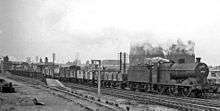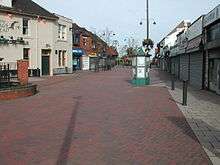Kirkby-in-Ashfield
| Kirkby-in-Ashfield | |
 Statue of Harold Larwood in Kirkby Market Place |
|
 Kirkby-in-Ashfield |
|
| Population | 20,672 (3 Wards. 2011) |
|---|---|
| OS grid reference | SK5056 |
| District | Ashfield |
| Shire county | Nottinghamshire |
| Region | East Midlands |
| Country | England |
| Sovereign state | United Kingdom |
| Post town | Nottingham |
| Postcode district | NG17 |
| Dialling code | 01623 |
| Police | Nottinghamshire |
| Fire | Nottinghamshire |
| Ambulance | East Midlands |
| EU Parliament | East Midlands |
| UK Parliament | Ashfield |
|
|
Coordinates: 53°06′N 1°15′W / 53.10°N 1.25°W
Kirkby-in-Ashfield is a market town in Nottinghamshire, England, with a population of 25,265 (according to the 2001 National Census), falling to 20,672 for the total of the 3 Ashfield Wards taken at the 2011 census. It is a part of the Mansfield Urban Area. The Head Offices of Ashfield District Council are located on Urban Road in the town centre.
Overview
Kirkby-in-Ashfield lies on the eastern edge of the Erewash Valley which separates Nottinghamshire and Derbyshire. Kirkby, as it is locally known, was originally a Danish settlement (Kirk-by translates as 'Church Town' in Danish) and is a collection of small villages including Old Kirkby, The Folly (East Kirkby), Nuncargate and Kirkby Woodhouse. It is mentioned in the Domesday Book and has two main churches: St Wilfrid's, a Norman church, which was gutted by fire on 6 January 1907 but quickly re-built to its former glory; and St Thomas's, built in the early 1910s in neo-gothic style.
Kirkby-in-Ashfield was once an important centre of coal mining and railways in west Nottinghamshire, with three active coal mines and several railway junctions.[1] The former Mansfield and Pinxton Railway from the Erewash Valley Line was joined here by the later Midland Railway line from Nottingham. The Great Central Railway main line passed to the south-west side of the town and had a double junction with the Great Northern Railway Leen Valley Extension line to Langwith Junction and the Mansfield Railway to Clipstone.
The town rapidly expanded during the Victorian era. However the closure of the coal mines in the 1980s and early 1990s led to a major slump in the local economy, and the area then suffered a high level of socio-economic depression.

The railways were closed during the Beeching era of the early 1960s when branch-line passenger services suffered widespread disruption, leaving the town without a link to central Nottingham and nearby Mansfield. The railway tracks were re-opened to passengers in the 1990s as part of the Robin Hood Line, providing links to other North Nottinghamshire towns and to Nottingham where a transport interchange allows transfer to the trams of Nottingham Express Transit system.
The town centre is undergoing a renovation during late 2014 and 2015 including the demolition of the old Co-Operative foodstore and county library with surrounding plaza, to be rebuilt with a central Morrisons store,[2] and is progressively changing from a traditional mining town to a commuter town for the surrounding areas, however the transition from industrial centre to dormitory town is in its infancy and will take some years to develop.
The town has two large secondary schools, Ashfield School and Kirkby College.

Local politics have been dominated by the Labour Party for much of the 20th century, however Ashfield attracted media attention in the late 1970s with a shock by-election win for the Conservatives. Since the 2010 General Election, the MP has been Gloria De Piero, best known for her work with GMTV. She took over from Geoff Hoon, one-time Secretary of State for Defence during the premiership of Tony Blair. She was elected with a very slim majority of 192 votes from the Liberal Democrats' Jason Zadrozny.
The town's most famous historical resident is Harold Larwood; the England cricketer who was born in Nuncargate in 1904, best known for his bodyline bowling in the Ashes Test series of 1932–33.
The area around St Wilfrid's Church is designated a conservation area, and consists of former farm buildings built from local stone, some of which are listed. In the conservation area, at the junction of Church Street, Chapel Street and Sutton Road, is Kirkby Cross. This is the remains of a thirteenth-century village cross in dressed stone, and is a listed structure and designated ancient monument.[3] It is thought the cross has been in place since 1218, some years before the village was granted a market and fair. It was nearly demolished by an articulated lorry in early December 1987, but has been restored.
On the edge of Kirkby is Portland Park (known to local people as "the quarries") a mixture of woodland and grassland areas which, together with a number of small ponds and streams, are home to a wide variety of wildlife. The visitor centre there was opened in October 1994, and is an environmentally friendly building and a centre of excellence for energy conservation.
The 1981 series of TV programmes 'Shillingbury Tales' were based on old Kirkby, as the writer Francis Essex's aunt lived nearby. The characters were based on locals who used to know his aunt. Filming was switched to Aldbury in Kent at the last minute because of costs and lack of space for filming.
Notable people
- Oliver Hynd MBE – 2012 Paralympic, Gold, Silver, Bronze medalist in swimming, younger brother of Sam Hynd
- Sam Hynd – 2008 Paralympic, double gold medalist in swimming.
- Harold Larwood – English Cricket Player – famous for the Ashes 'Bodyline Series'
- Bill Voce – English Cricket Player – associated alongside Harold Larwood for the Ashes 'Bodyline Series'
- Dave Thomas – former English Footballer, played for Everton, Burnley and Queens Park Rangers.
Places of interest
See also
- Kirkby-in-Ashfield railway station
- St. John the Evanglist's Church, Kirkby-in-Ashfield
- St. Wilfrid's Church, Kirkby-in-Ashfield
- Hollinwell incident
References
- ↑ Railway Junction Diagrams 1914 page 143, Ian Allan Ltd reprint, ISBN 0-7110-1256-3
- ↑ £2.4 million facelift for Kirkby is announced Chad, local newspaper, 13 August 2014. Retrieved 21 September 2015
- ↑ "1012926 – The National Heritage List for England".
| Wikimedia Commons has media related to Kirkby in Ashfield. |